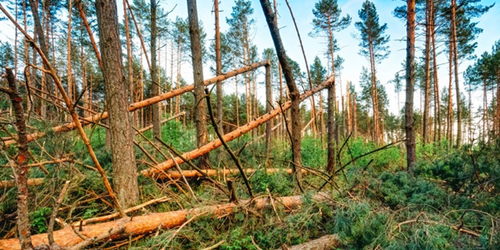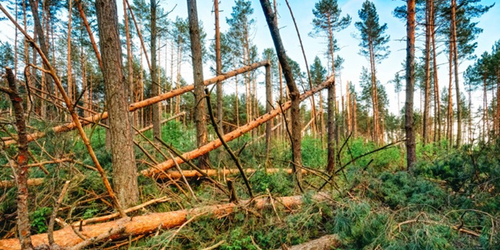Trees Crumbling in the Wind
Cyclone Klaus struck a large swath of Western Europe in 2009, damaging millions of trees of all types and sizes, from towering oaks to bushy pines. Observations of the aftermath revealed the greatest damage (more than 60% of trees knocked down) occurred in regions where the winds topped 90 miles per hour (40 m/s). A new analysis shows that this critical wind speed is derivable from a few simple scaling laws.
A tall thick tree should be just as strong as a short thin tree. Many scientists, including Leonardo da Vinci and Galileo, have shown this to be true for wooden beams, but they haven’t agreed on how the force needed to snap a beam scales with its length and diameter. To better characterize wood strength, Emmanuel Virot of the École Polytechnique, France, and his colleagues performed simple experiments on horizontally held rods made from beech. Fixing one end, the researchers applied increasing weight at the other, recording the curvature of the rod as it bent and eventually snapped.
The data showed that wood breaks at a critical curvature radius, which depends on the diameter and length of the rod. Using this relation and a model of wind force, the researchers arrived at a scaling law for the wind speed at which a tree breaks ( ). Previous studies have shown that trees nearly triple in diameter for a doubling in their height ( ) which means the critical wind speed only weakly depends on tree height ( ). The speed does not depend on the elastic modulus of the wood, which is consistent with data showing that hardwoods (e.g., oaks) are just as wind susceptible as softwoods (e.g., pines).
This research is published in Physical Review E.
–Michael Schirber





